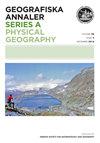Geochemical records of paleocontamination in late pleistocene lake sediments in West Flanders (Belgium)
IF 1.8
4区 地球科学
Q3 GEOGRAPHY, PHYSICAL
Geografiska Annaler Series A-Physical Geography
Pub Date : 2018-04-03
DOI:10.1080/04353676.2017.1408955
引用次数: 0
Abstract
ABSTRACT Concentrations of trace elements in Late Pleistocene lake sediments from two localities in West Flanders (Belgium) were studied using inductively coupled plasma-mass spectrometry. The studied sediments were deposited during the transition of the Allerød to the Younger Dryas. Trace elements enter lake environments from a variety of sources, but mostly from bedrock weathering in catchments and as wind-blown dust particles. These sources create a natural trace element background in lake sediment records. The concentration and distribution of trace elements across the studied lake sediment sequences display features consistent with inputs of materials other than those from soil or bedrock. Input from volcanic eruptions, biomass burning and meteorite impacts should be considered among the main sources of non-anthropogenic contamination of lake environments.比利时西佛兰德斯晚更新世湖泊沉积物古污染地球化学记录
采用电感耦合等离子体质谱法研究了比利时西佛兰德斯两个地区晚更新世湖泊沉积物中微量元素的浓度。所研究的沉积物沉积于阿勒谷期到新仙女木期的过渡时期。微量元素从各种来源进入湖泊环境,但主要来自集水区的基岩风化和风吹的尘埃颗粒。这些来源在湖泊沉积物记录中创造了自然的微量元素背景。研究的湖泊沉积物层序中微量元素的浓度和分布与土壤和基岩以外的物质输入特征一致。火山喷发、生物质燃烧和陨石撞击等是非人为污染湖泊环境的主要来源。
本文章由计算机程序翻译,如有差异,请以英文原文为准。
求助全文
约1分钟内获得全文
求助全文
来源期刊
CiteScore
3.60
自引率
0.00%
发文量
12
审稿时长
>12 weeks
期刊介绍:
Geografiska Annaler: Series A, Physical Geography publishes original research in the field of Physical Geography with special emphasis on cold regions/high latitude, high altitude processes, landforms and environmental change, past, present and future.
The journal primarily promotes dissemination of regular research by publishing research-based articles. The journal also publishes thematic issues where collections of articles around a specific themes are gathered. Such themes are determined by the Editors upon request. Finally the journal wishes to promote knowledge and understanding of topics in Physical Geography, their origin, development and current standing through invited review articles.

 求助内容:
求助内容: 应助结果提醒方式:
应助结果提醒方式:


